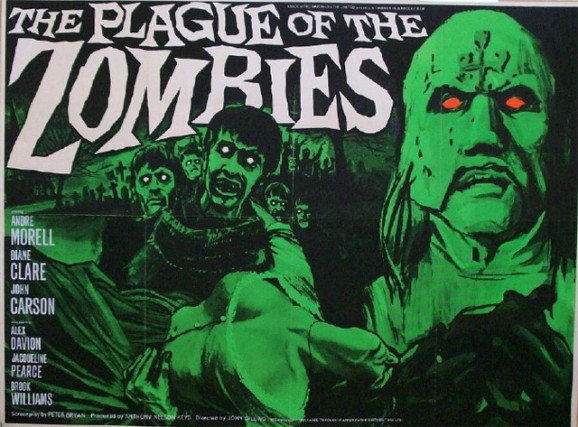In 1860, a rural Cornish village has been struck by a mysterious sickness which is killing off members of the community at an alarming rate. Baffled, the local GP Peter Thompson (Brook Williams) calls in his old university mentor Sir James Forbes (Andre Morell) to help him find out what the disease is and to destroy it. Forbes and his young daughter Sylvia (Diane Clare) arrive to find that Thompson has lost all confidence in his ability and the locals have lost all faith in him too. Two more deaths follow in the village including Thompson’s beloved wife Alice (Jacqueline Pierce) before it finally transpires that the laird of the community, Squire Hamilton (John Carson), has been practicing witchcraft in order to kill off certain people before raising them from the dead as zombies for cheap labor in his tin mine. Forbes and Thompson have to fight their way through the superstitious and narrow minded ways of the locals in order to stop Hamilton before he eliminates the entire community and his next intended victim is Sylvia!
The Plague Of The Zombies was shot back-to-back with Hammer’s other Cornish shocker, The Reptile, by director John Gilling at the legendary Bray Studios, Berkshire, England during the summer of 1965. Both pictures shared the same sets and these were redressed accordingly to their required use. But if you watch The Reptile you will recognise the same village and graveyard sets! It is worth noting that The Reptile is also rich in atmosphere despite the low budget and the limitations that back-to-back shooting would suggest. Both Plague and The Reptile were released as supporting features to two of Hammer’s main features the following year. The Reptile supported Rasputin The Mad Monk (March 1966) and The Plague Of The Zombies went out with Dracula Prince Of Darkness in January 1966. Yet despite their second feature status, both of Gilling’s films outshone the main feature.
When I first saw The Plague Of The Zombies some seven years ago when it was shown late one Friday night on Channel 4, I didn’t think that it was going to be very good judging by the plot synopsis in my film guide. But when the end credits rolled, I was astonished by just how good it really was. During the fifties, John Gilling had directed a number of quota-quickie pictures and some of them were very mediocre, but here he takes a rather dubious storyline and gives it a lot of weight by emphasising the distinct contrast between the superstitious country folk and the more forward thinking men of science and the lengths that the latter have to go to in order to solve the mystery. For instance, they have been refused the right to perform any autopsies so it isn’t until Alice dies that Forbes has to persuade Thompson to allow him to perform an autopsy to try and find out the cause of death. In addition, there is an imaginatively staged green-tinted nightmare sequence, which is still talked about by horror buffs and it has been suggested that it inspired George A Romero when he made his Night Of The Living Dead only a few years later. In this memorable sequence Thompson sees the dead rise from their graves. This turns out to be a premonition as after he awakens, Forbes and the local police sergeant (Michael Ripper) exhume all the graves to find them empty.
The Plague Of The Zombies also features fine performances from Andre Morell as Sir James Forbes portraying him as a charming, intelligent and resourceful man of science who is prepared to do anything for the benefit of good even though the superstitious locals don’t always understand his methods and can’t understand that what he’s doing can only ultimately save them. Morell’s performance is strong enough to rank among the best of Hammer’s screen heroes such as Peter Cushing’s Sherlock Holmes and Christopher Lee’s Duc De’ Richeleau. Brook Williams offers good support as Peter Thompson whilst Jacqueline Pierce is standout as his wife whom has to be decapitated by a shovel in order to save her from being enslaved to the cult of the undead forever. John Carson is suitably suave as the evil Squire Hamilton and ever present is the reliable Michael Ripper who played virtually everything for Hammer over the years including pirates, old soaks and pub landlords and here he is equally versatile in the role of the sympathetic Sgt Swift.
In summary, many people agree (including myself) that The Plague Of The Zombies is John Gilling’s finest hour as a director as this assignment gave him more opportunities than the quota-quickies to exploit the setting and place emphasis on the class structure of the time thus giving more weight to the plot. In addition, Bernard Robinson’s sets are excellent and Arthur Grant’s cinematography is suitably atmospheric.

